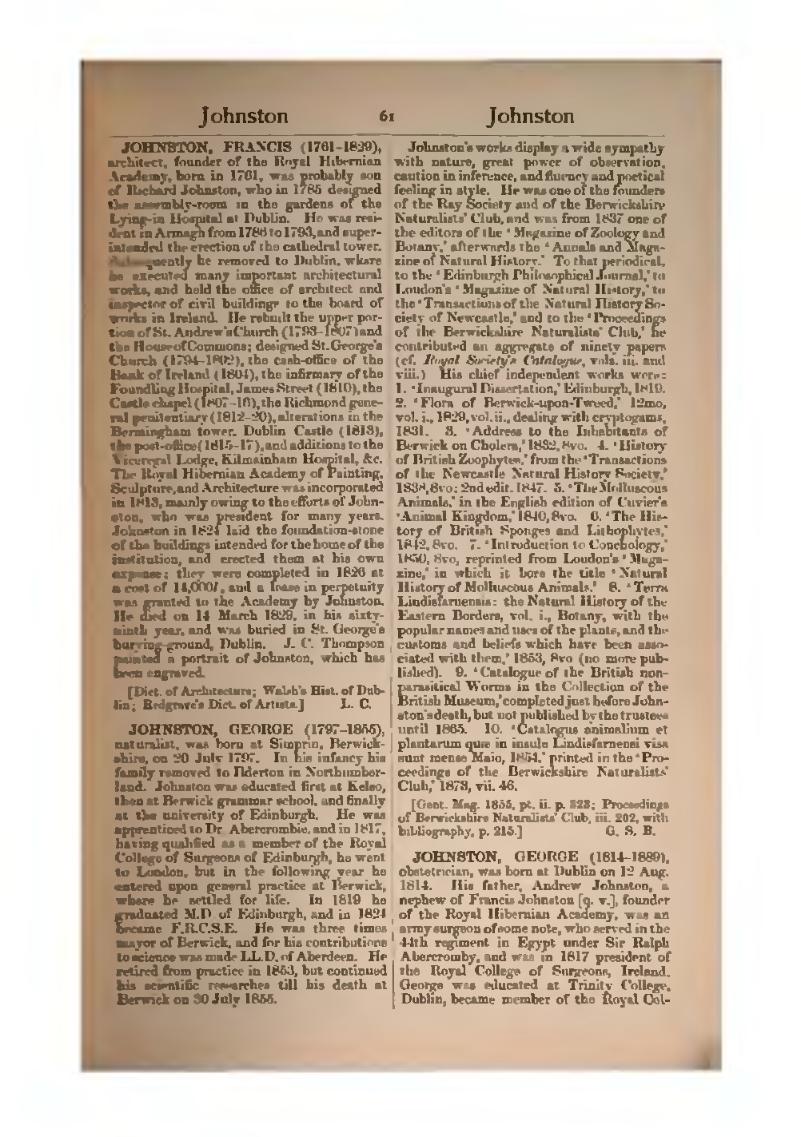JOHNSTON, FRANCIS (1761–1829), architect, founder of the Royal Hibernian Academy, born in 1761, was son of William Johnston, architect, of Armagh. His eldest brother, Richard Johnston (d. 1806), in 1785 designed the assembly-room in the gardens of the Lying-in Hospital at Dublin. Francis was resident in Armagh from 1786 to 1793, and superintended the erection of the cathedral tower. Subsequently he removed to Dublin, where he pursued his profession and was architect and inspector of civil buildings to the board of works in Ireland. He rebuilt the upper portion of St. Andrew's Church (1793–1807) and the House of Commons; designed St. George's Church (1794–1802), to which he presented a peal of eight bells, the cash-office of the Bank of Ireland (1804), the infirmary of the Foundling Hospital, James Street (1810), the Castle chapel (1807–16), the Richmond general penitentiary (1812–20), alterations in the Bermingham tower, Dublin Castle (1813), the post-office (1815–17), and additions to the Viceregal Lodge, Kilmainham Hospital, &c. The Royal Hibernian Academy of Painting, Sculpture, and Architecture was incorporated in 1813, mainly owing to the efforts of Johnston, who was president for many years. Johnston in 1824 laid the foundation-stone of the buildings intended for the home of the institution, and erected them at his own expense; they were completed in 1826 at a cost of 14,000l., and a lease in perpetuity was granted to the Academy by Johnston. He died on 14 March 1829, and was buried in St. George's burying-ground, Dublin. Martin Creggan painted a portrait of Johnston, which is in the council chamber of the Royal Hibernian Academy. There are other portraits by J. C. Thompson (engraved), Comerford, and in a family group by Creggan.
[Burke's Landed Gentry; Dict. of Architecture; Walsh's Hist. of Dublin.]
JOHNSTON, GEORGE (1797–1855), naturalist, was born at Simprin, Berwickshire, on 20 July 1797. In his infancy his family removed to Ilderton in Northumberland. Johnston was educated first at Kelso, then at Berwick grammar school, and finally at the university of Edinburgh. He was apprenticed to Dr. Abercrombie, and in 1817, qualifying as a member of the Royal College of Surgeons of Edinburgh, he went to London, but in 1818 he began for life practice at Berwick. In 1819 he graduated M.D. of Edinburgh, and in 1824 became F.R.C.S.E. He was thrice mayor of Berwick, and became LL.D. of Aberdeen. He retired from practice in 1853, and died at Berwick on 30 July 1855.
Johnston's works display a wide sympathy with nature, great power of observation, caution in inference, and fluency and poetical feeling in style. He was one of the founders of the Ray Society and of the Berwickshire Naturalists' Club, and was from 1837 one of the editors of the ‘Magazine of Zoology and Botany,’ afterwards the ‘Annals and Magazine of Natural History.’ To that periodical, to the ‘Edinburgh Philosophical Journal,’ to Loudon's ‘Magazine of Natural History,’ to the ‘Transactions of the Natural History Society of Newcastle,’ and to the ‘Proceedings of the Berwickshire Naturalists' Club,’ he contributed an aggregate of ninety papers (cf. Royal Society's Catalogue, vols. iii. and viii.). His chief independent works were:
- ‘Inaugural Dissertation,’ Edinburgh, 1819.
- ‘Flora of Berwick-upon-Tweed,’ 12mo, vol. i., 1829, vol. ii., dealing with cryptogams, 1831.
- ‘Address to the Inhabitants of Berwick on Cholera,’ 1832, 8vo.
- ‘History of British Zoophytes,’ from the ‘Transactions of the Newcastle Natural History Society,’ 1838, 8vo; 2nd edit. 1847.
- ‘The Molluscous Animals,’ in the English edition of Cuvier's ‘Animal Kingdom,’ 1840, 8vo.
- ‘The History of British Sponges and Lithophytes,’ 1842, 8vo.
- ‘Introduction to Conchology,’ 1850, 8vo, reprinted from Loudon's ‘Magazine,’ in which it bore the title ‘Natural History of Molluscous Animals.’
- ‘Terra Lindisfarnensis: the Natural History of the Eastern Borders, vol. i., Botany, with the popular names and uses of the plants, and the customs and beliefs which have been associated with them,’ 1853, 8vo (no more published).
- ‘Catalogue of the British non-parasitical Worms in the Collection of the British Museum,’ completed just before Johnston's death, but not published by the trustees until 1865.
- ‘Catalogus animalium et plantarum quæ in insula Lindisfarnensi visa sunt mense Maio, 1854,’ printed in the ‘Proceedings of the Berwickshire Naturalists' Club,’ 1873, vii. 46.
[Gent. Mag. 1855, pt. ii. p. 323; Proceedings of Berwickshire Naturalists' Club, iii. 202, with bibliography, p. 215.]
JOHNSTON, GEORGE (1814–1889), obstetrician, was born at Dublin on 12 Aug. 1814. His father, Andrew Johnston, a brother of Francis Johnston [q. v.], founder of the Royal Hibernian Academy, was an army surgeon of some note, who served in the 44th regiment in Egypt under Sir Ralph Abercromby, and was in 1817 president of the Royal College of Surgeons, Ireland. George was educated at Trinity College, Dublin, became member of the Royal Col-
